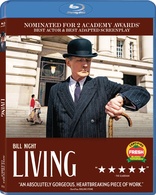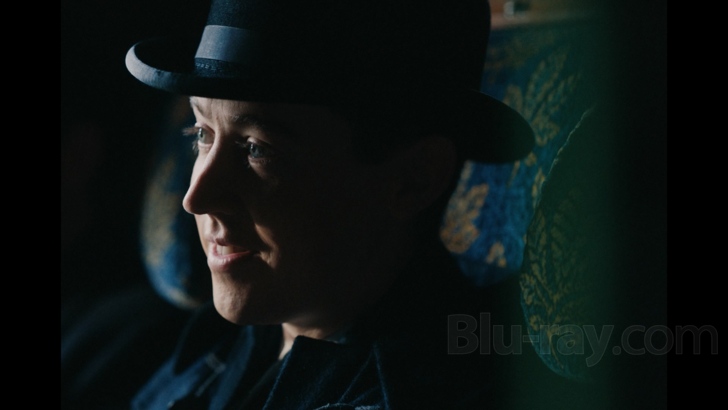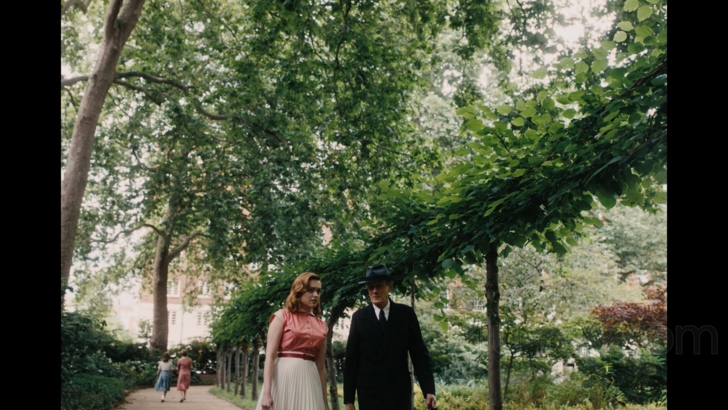Living Blu-ray Movie
HomeLiving Blu-ray Movie 
Sony Pictures | 2022 | 102 min | Rated PG-13 | Apr 11, 2023
Movie rating
7.5 | / 10 |
Blu-ray rating
| Users | 0.0 | |
| Reviewer | 3.5 | |
| Overall | 3.5 |
Overview
Living (2022)
An English-language adaptation of the script of "Ikiru" (1952), set in London in the 1950s.
Starring: Bill Nighy, Aimee Lou Wood, Alex Sharp (II), Adrian Rawlins, Tom BurkeDirector: Oliver Hermanus
| Drama | 100% |
Specifications
Video
Video codec: MPEG-4 AVC
Video resolution: 1080p
Aspect ratio: 1.48:1
Original aspect ratio: 1.50:1
Audio
English: DTS-HD Master Audio 5.1
Subtitles
English, English SDH, French, Spanish
Discs
Blu-ray Disc
Single disc (1 BD)
Playback
Region A (B, C untested)
Review
Rating summary
| Movie | 3.5 | |
| Video | 4.5 | |
| Audio | 4.5 | |
| Extras | 1.0 | |
| Overall | 3.5 |
Living Blu-ray Movie Review
Reviewed by Dr. Stephen Larson April 20, 2023The subject of an aging bureaucrat who receives a terminal cancer diagnosis that must decide how to make the most of his remaining time was masterfully told by Akira Kurosawa in Ikiru (1952). Kurosawa and his two co-writers, Shinobu Hashimoto and Hideo Oguni, set their drama in a postwar Tokyo that was undergoing rapid economic and social changes. Novelist Kazuo Ishiguro, a Japanese native who later moved to London with his family, also sets his Living screenplay during the 1950s when Britain was trying to revitalize its economy after the war. Ishiguro states in an interview on this disc that although Ikiru was one of his favorite films, he didn't re-watch it while writing the script so Living could function on its own terms. Bill Nighy plays the same role that Takashi Shimura occupied in the original. Nighy portrays Mr. Williams with similar introspective qualities as Shimura did for Mr. Watanabe. Williams heads the civil service division at London County Council’s Public Works Department where stacks of papers surround his placid appearance. A widower, Williams performs his clerical job with the same stoicism each day. When he learns from his doctor that he has an unspecified cancer (possibly gastric like Watanabe had), he can't bring himself to confide it to his son, Michael (Barney Fishwick), and daughter-in-law Fiona (Patsy Ferran). Williams reassesses his life and takes a leave from the PWD. He meets Mr. Sutherland (Tom Burke), who takes him to the amusement park for drinks, fun, and games. But Williams is growing weaker and doesn't have the stamina to sing a full rendition of his favorite ballad, "The Rowan Tree," although he tries. It isn't until he goes out with Miss Margaret Harris (Aimee-Lou Wood), one of his younger office workers, that Williams fully reawakens. Margaret is moving on to another employer where she hopes to get the assistant manager vacancy. Margaret is sweet and gentle so she makes a more calming presence for Williams to divulge his sad news rather than his own son. Williams begins enjoying life around Margaret the most since his younger years. Before Williams took his leave, a group of local women visited his office about transforming their squalid neighborhood on Chester Street (once a bombsite) into a playground. Williams remembers their plea and embraces it as a final opportunity to build his legacy.

Head of the civil service desk.
Where there are some differences between Ikiru and Living, Ishiguro sticks close to the original. (Ikiru's screenplay was fairly loosely based on Leo Tolstoy's 1886 novella, The Death of Ivan Ilyich.) Ishiguro has added a narrator, Peter Wakeling (Alex Sharp), who probably works the closest with Williams at the PWD. Sharp delivers a fine performance as Wakeling, even if he's a secondary character to Williams and Harris. Merchant-Ivory's film adaptation of Ishiguro's The Remains of the Day is about an English gentleman (Mr. Stevens, Lord Darlington's head butler), who has nostalgia and a mixture of yearning and sadness for past events in his life. Nighy imbues Williams with those same characteristics when he thinks back to family life in the English countryside. (This is where the movie subtly shifts from color to black and white.) Shimura is likewise inward-looking in Ikiru.
As someone who's seen the Kurosawa picture multiple times, a ring of familiarity pervaded my viewing of Living. I knew the original story and many of the scenes played out in more or less the way I anticipated that they would. The last third or so of Living is essentially about Williams's personal drama. While this is both wrenching and affective, the narrative doesn't have the same sociocultural critique of postwar London that Kuroswa's does of Tokyo after the war. This may have to do with Ikiru being about contemporaneous circumstances facing Japan's capital. Ishiguro's treatment of London is more nostalgic, with a longing for a bygone era. Living thus lacks Ikiru's social criticism.
Living Blu-ray Movie, Video Quality 

Sony Pictures Classics has released Living using the MPEG-4 AVC codec on a BD-50 (disc size: 33.22 GB). South African auteur Oliver Hermanus's fifth feature appears in its originally composed ratio of 1.48:1, which is the same unique framing that he and cinematographer Jamie Ramsay shot Moffie (2019). Living was shot on the ARRI Alexa Mini (3.4K) with large-format ZEISS Supreme lenses. All indications are that the DI was finished in 2K. The picture has a textural look to it that's reminiscent of the British films of the 1950s (a period that Hermanus and Ramsay surely studied). In an interview with Helen Parkinson of British Cinematographer Magazine, Ramsay says he wanted a look "reminiscent of crisp film print that has been hand processed to perfection". Colorist Joseph Bicknell, who also worked on Moffie, received a slew of stills from Ramsay that covered postwar UK and which used early Kodachrome 35 mm stock. Ramsay chose not to photograph on celluloid, explaining to Parkinson: "The print feeling was a more stills photography-driven look – that different way of processing and exposing. Even if film was on the cards, I don't know if I'd have opted for it because I have so much more control in getting that look on digital."
Sony's transfer sports inky blacks on the suits and bowler hats worn by the civil servants (see Screenshot#s 3, 7, and 14). Blacks are very crisp throughout. For the amusement park scenes, Ramsay used warm practical bulbs and reds (see frame grabs 4, 9, and 16). Bright natural light filters through the windows of a seaside café (#13) and behind Mrs. Harris at a restaurant (#12). Screen capture #17 is the documentary aesthetic that Hermanus and Ramsay wanted to replicate. Sony encodes the feature at a mean video bitrate of 34762 kbps. I noticed what may be mastering errors in #s 22 and 23. In the former, you can see a little line above the pail. In the latter, a line over the window pane is visible.
Sixteen scene selections can be chosen from the menu or via remote.
Living Blu-ray Movie, Audio Quality 

Sony has supplied a DTS-HD Master Audio 5.1 Surround mix (2117 kbps, 16-bit). British accents and dialogue are generally comprehensible. Nighy sometimes mumbles his lines but that's part of his character. Sounds from the train engine are clearly audible. Street noise and other ambience make their presence known. The first half of Emilie Levienaise-Farrouch's wonderful score is melancholic with low strings. The second half is more buoyant. Low-key piano tunes are heard on a few cues while others consist of free-flowing piano rhapsodies that capture the changes in Mr. Williams's personality. They remind me of Michael Nyman's music at times. Lisa Knapp delivers a pitch-perfect vocal while performing "The Rowan Tree". There are also source cues with music by Debussy, Dvorák, and Kern. I feel the surrounds are used effectively when they're selectively output with music and f/x.
Sony provides several subtitling options in English, Chinese, French, Portuguese, Spanish, and Thai.
Living Blu-ray Movie, Special Features and Extras 

- A Life Semi-lived (4:37, 1080p) - a short EPK featurette that mixes clips from Living, B-roll footage, and interview bits with star Bill Nighy, writer/executive producer Kazuo Ishiguro, actress Aimee Lou Wood, and director Oliver Hermanus. In English with optional subtitles available in English, Mandarin, Portuguese, Spanish, and Thai.
- Theatrical Trailer (1:42, 1080p) - Sony's official trailer for Living, which is presented in 1.48:1 (average bitrate: 18014 kbps) and 5.1 Surround sound (640 kbps).
- Bonus Previews - trailers for other SPC titles, which include Return to Seoul, One Fine Morning, The Son, The Phantom of the Open, and Mothering Sunday.
Living Blu-ray Movie, Overall Score and Recommendation 

Living is a classical, well-made postwar drama that's best appreciated if you haven't seen Ikiru before. Even though Ishiguro didn't watch it before penning his screenplay, the Kurosawa influence is evident throughout. Living's strongest parts are the performances by the principals, the vintage period look that Ramsay captures with his camera, and the original score. Compared to Living, Hermanus's queer drama Moffie is just as moving. I'd recommend seeing the earlier picture first. Sony Classics offers a sharp transfer with just a couple of flaws. I don't think that it would look much better if released on 4K UHD. You're better off picking up this release (with a workman DTS-HD MA 5.1 mix) than purchasing one of the streaming options.
Similar titles
Similar titles you might also like

Moonlighting
1982

I, Daniel Blake
2016

Loveless
Нелюбовь / Nelyubov
2017

Taxi
2015

Death of a Cyclist
Muerte de un ciclista
1955

Expresso Bongo
1959

Horse Money
Cavalo Dinheiro
2014

Vera Drake
2004

The Front
Limited Edition to 3000
1976

Salt of the Earth
70th Anniversary Limited Edition(Archive Collection
1954

1984
1984

Things to Come
1936

Gideon of Scotland Yard
Choice Collection
1958

The Confession
L'aveu
1970

Insignificance
1985

The Horse's Mouth
1958

The Day the Earth Caught Fire
1961

The Ones Below
2015

The Young Pope
2016-2017

Privilege
1967